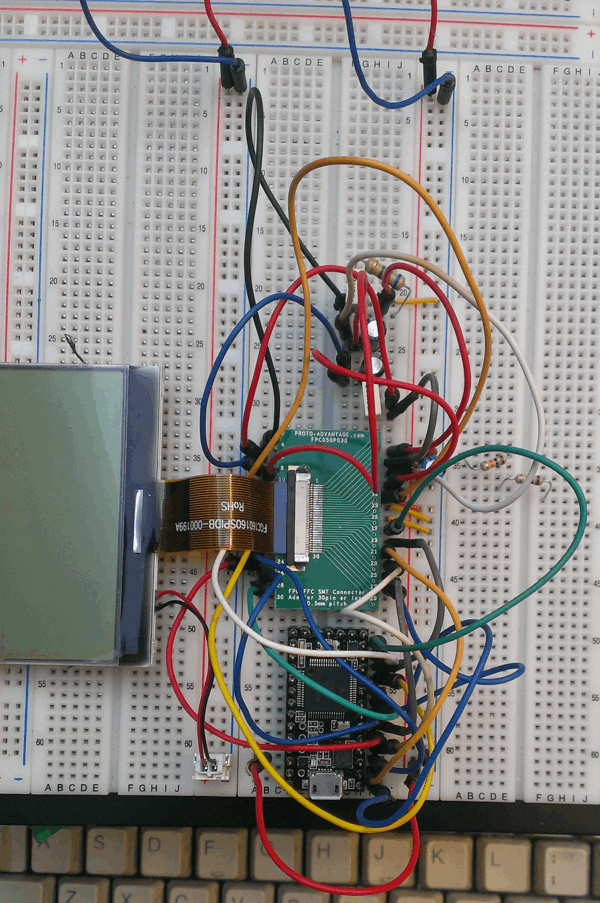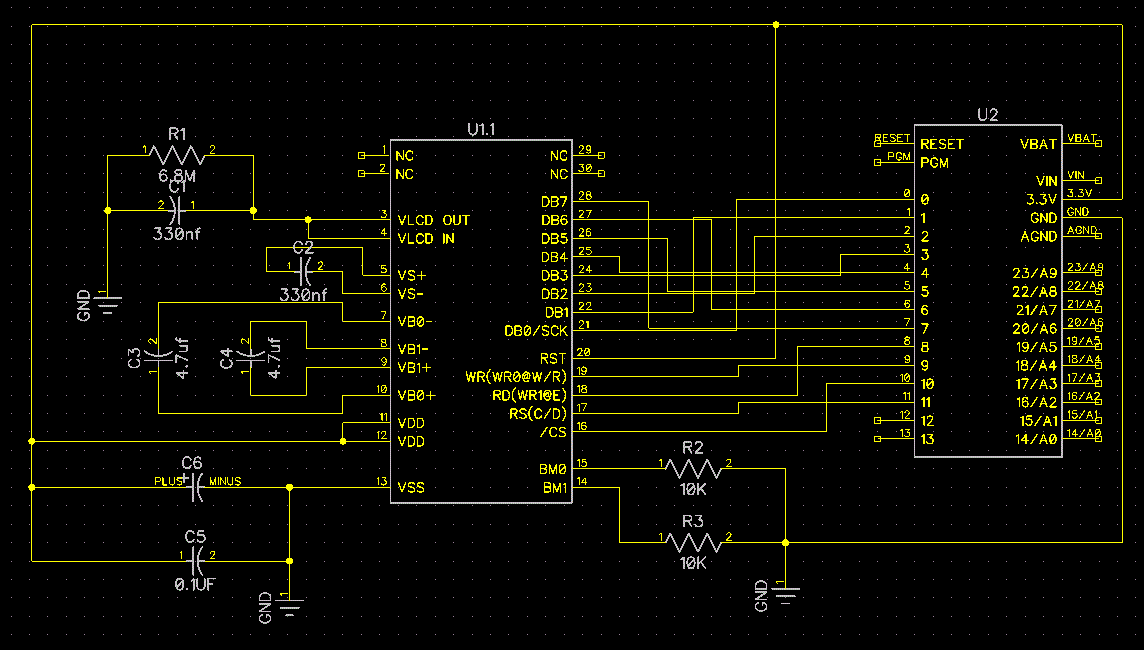-
Troubleshooting
03/23/2014 at 19:47 • 0 commentsOkay, I still haven't gotten anything to display on the LCD.
Probing with a scope shows that the communication between the teensy and the module looks alright.
I even see voltages on some of the pins react proportional to the amount of pixels I'm allegedly writing to the screen. When the code was writing full black for a second and then full white for a second I could see the voltages on all the V lines go up or down with one second frequency. Changing the code to slowly ramp up and down the amount of pixels also shows gradually changing voltages.
I'm just not seeing anything on the display itself.
I also tried sweeping through the 0-255 range on the contrast register, and while this did show corresponding changes on the voltage pins, it did not show any change on the display itself.
Just to be sure I swapped out the LCD module for another and get the exact same result.
The datasheet page 32-34 seems to suggest that VLCD (pin 3 and 4) should be producing between 12 and 18 volts.
I'm seeing between 1.7 and 2.4 volts on those pins.
Unfortunately I'm running out of ideas on what could be going wrong. Does anyone have any suggestions?
-
So far
03/16/2014 at 10:19 • 0 commentsI've got four EastRising LCD modules from www.buydisplay.com.
I've got a Teensy 3.0 from Paul Stoffregen
I've got a workspace stocked with all kinds of tools and components.
The LCD modules comes with a FPC cable so I ordered some
30 Pins 0.50mm Pitch ZIF Connectors along with them. For prototyping I got a couple of FPC/FFC SMT Connector DIP adapters from Proto Advantage.These are awesome for breaking out a flexible cable to a breadboard. A quick EEVBlog SMD soldering tutorial later and I had the cable connected to a breadboard easily.I then breadboarded up what I think is a fairly accurate representation of the ERC160160-2 Series Interfacing Example Drawing
![]()
And a diptrace schematic of same.
![]()
I've used the Teensy 3.0 rather than an 8080 MPU as used in the example.
I'm also using the Teensy 3.3v output to power the display at the moment. I'm not yet sure about how I want to power the entire project later on. Battery? 5V wall-wart adapter with LM1117 conversion to 3.3v? Usb cable to Teensy?
The single display (including backlight) already consumes 92mA so that could become a problem later.
The display modules use the UC1698 driver chip, but unfortunately not all of its capabilities are available. Most unfortunate of which is that the SPI mode of the UC1698 is not available :(
The pins (db13 & db15) needed to configure the driver for serial mode are not available on the cable. So the only choices left are the 8-bit 8080 or 6800 parallel modes. Which requires lots of pins (12) to address the display. The plan is to connect all the pins of all three displays together, except for the CS pins.
Fortunately the Teensy 3,0 has plenty of pins available.
I've also taken the ERC160160-2 Series Demo Code and ported the important bits:
/* Quick & dirty port of main bits of demo code. */ const int D0 = 0; const int D1 = 1; const int D2 = 2; const int D3 = 3; const int D4 = 4; const int D5 = 5; const int D6 = 6; const int D7 = 7; const int WR1 = 8; const int WR0 = 9; const int CS0 = 10; const int CD = 11; void setup() { Serial.begin(9600); delay(1000); Serial.println("Setup"); pinMode(D0, OUTPUT); pinMode(D1, OUTPUT); pinMode(D2, OUTPUT); pinMode(D3, OUTPUT); pinMode(D4, OUTPUT); pinMode(D5, OUTPUT); pinMode(D6, OUTPUT); pinMode(D7, OUTPUT); pinMode(WR1, OUTPUT); pinMode(WR0, OUTPUT); pinMode(CS0, OUTPUT); pinMode(CD, OUTPUT); init(); } void output(uint cl) { digitalWriteFast(WR1, HIGH); digitalWriteFast(WR0, LOW); ((cl & 0x01)) ? digitalWriteFast(D0, HIGH) : digitalWriteFast(D0, LOW); ((cl & 0x02)) ? digitalWriteFast(D1, HIGH) : digitalWriteFast(D1, LOW); ((cl & 0x04)) ? digitalWriteFast(D2, HIGH) : digitalWriteFast(D2, LOW); ((cl & 0x08)) ? digitalWriteFast(D3, HIGH) : digitalWriteFast(D3, LOW); ((cl & 0x10)) ? digitalWriteFast(D4, HIGH) : digitalWriteFast(D4, LOW); ((cl & 0x20)) ? digitalWriteFast(D5, HIGH) : digitalWriteFast(D5, LOW); ((cl & 0x40)) ? digitalWriteFast(D6, HIGH) : digitalWriteFast(D6, LOW); ((cl & 0x80)) ? digitalWriteFast(D7, HIGH) : digitalWriteFast(D7, LOW); digitalWriteFast(WR0, HIGH); } void write_com(uint para) { Serial.print("Command: "); Serial.println(para, HEX); digitalWriteFast(CS0, LOW); digitalWriteFast(CD, LOW); output(para); digitalWriteFast(CS0, HIGH); } void write_data(uint para) { digitalWriteFast(CS0, LOW); digitalWriteFast(CD, HIGH); output(para); digitalWriteFast(CS0, HIGH); } void init() { delay(200); write_com(0xe2); // set system reset delay(100); //delayms 200ms /*power control*/ write_com(0xe9); //Bias Ratio:1/10 bias write_com(0x2b); //power control set as internal power write_com(0x24); //set temperate compensation as 0% write_com(0x81); //electronic potentionmeter write_com(0xbf); /*display control*/ write_com(0xa4); //all pixel off write_com(0xa6); //inverse display off /*lcd control*/ write_com(0xc4); //Set LCD Maping Control (MY=1, MX=0) write_com(0xa1); //line rate 15.2klps write_com(0xd1); //rgb-rgb write_com(0xd5); //4k color mode write_com(0x84); //12:partial display control disable /*n-line inversion*/ write_com(0xc8); write_com(0x10); //enable NIV /*com scan fuction*/ write_com(0xda); //enable FRC,PWM,LRM sequence /*window*/ write_com(0xf4); //wpc0:column write_com(0x25); //start from 112 write_com(0xf6); //wpc1 write_com(0x5A); //end:272 write_com(0xf5); //wpp0:row write_com(0x00); //start from 0 write_com(0xf7); //wpp1 write_com(0x9F); //end 160 write_com(0xf8); //inside mode write_com(0x89); //RAM control /*scroll line*/ write_com(0x40); //low bit of scroll line write_com(0x50); //high bit of scroll line write_com(0x90); //14:FLT,FLB set write_com(0x00); /*partial display*/ write_com(0x84); //12,set partial display control:off write_com(0xf1); //com end write_com(0x9f); //160 write_com(0xf2); //display start write_com(0); //0 write_com(0xf3); //display end write_com(159); //160 display_address(); display_white(); write_com(0xad); //display on,select on/off mode.Green Enhance mode disable } void display_address() { write_com(0x60); //row address LSB write_com(0x70); //row address MSB write_com(0x12); //column address MSB write_com(0x05); //column address LSB } void display_black() { uint i,j; for(i=0;i<160;i++) { for(j=0;j<81;j++) { write_data(0xff); } } } void display_white() { uint i,j; for(i=0;i<160;i++) { for(j=0;j<81;j++) { write_data(0x00); } } } void loop() { display_address(); display_black(); delay(1000); display_address(); display_white(); delay(1000); }What I haven't got is any kind of reaction on the display.
I suspect there's something wrong with the power-side of the display module. And this is where I really run in to my inexperience. I'm by trade a software guy. Easy, everything is 1 or 0. This analog stuff is throwing me for a loop with all the capacitors, resistors, different voltages, current flows etc.
I'll get into debugging in another post next weekend hopefully.
 kender.arg
kender.arg
